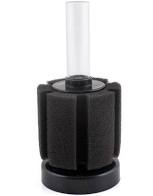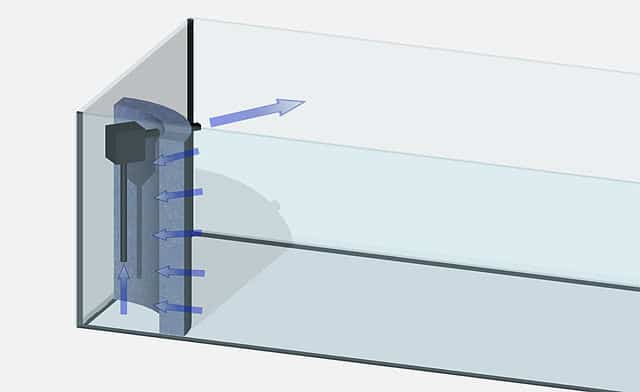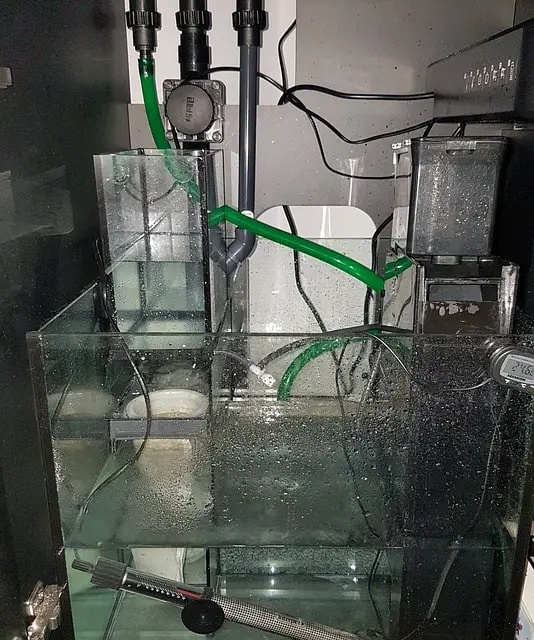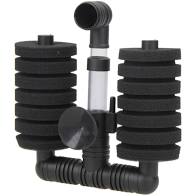There are many kinds of filters to choose from when setting up a shrimp tank. Sponge filters, Mattenfilters, under gravel filters, hang-on the back filters, and canister filters. We will look into these filters to see What are the pros and cons For each type and which one will be the best for Shrimp.
The best filter to choose for a shrimp tank, in my opinion, is either a sponge filter or a Mattenfilter. Sponge filters and Mattenfilters have large surface areas where Shrimp can graze on, and these filters also have the benefit that they don’t suck small shrimps into the filter.
Sponge filters
Sponge filters are simply large sponges where are water gets sucked through them by airlift or by a water pump. The most common ones are sponges with a tube in them.
Air is pumped into the bottom of the tube, often trough an airstone to get smaller air bubbles. The air bubbles lift water in the tube, and water gets sucked through the sponge.
Sponge filters only require an air pump or, in some cases, a water pump. They are straightforward, and they have no moving mechanical parts. Because of that, they hardly ever break down.
I use sponge filters in most of my aquariums. A lot of times, you will see shrimp grazing on the surface of the sponge. The only major disadvantage of a sponge filter can be the fact they take up a lot of space in your aquarium.

If you don’t mind, a sponge filter can be an excellent filter for almost any aquarium. Sponge filters are one of the most energy-efficient filters for larger Shrimp and fish rooms because one air pump can power a lot of sponge filters.
Mattenfilters
A Mattenfilter has a lot of the same advantages as a sponge filter, a lot of surface area for Shrimp to Graze on. They have no moving parts, and gentle water flow.
And no way for your little Shrimp to get sucked into the filter.
Like a sponge filter, it uses air or a small water pump to get the water flowing through the filter. The Mattenfilter takes even more room in your aquarium than a sponge filter, but it also has more surface area.

Mattenfilters are not as much seen on in the hobby than most other forms of filters even though they are very good at their job. You will see this kind of filter more often in a professional setup, for instance, in fish or shrimp breeding rooms.
These kinds of filters are easy to install yourself, and if you take the time to build on into your shrimp tank, you will find them very efficient at filtering water. It is only a little bit more challenging to install than a sponge filter.
Under Gravel Filters
Under gravel filters, use the gravel substrate to filter the water. Like sponge filters, they don’t have any moving parts that can break down.
Under gravel filters are very useful, but they can be challenging to install in a new aquarium and almost impossible in an established tank. Cleaning them is also a big hassle because it would mean disturbing the substrate.
The advantages of an under gravel filter are they don’t take a lot of space in your aquarium. Most of the filter is hidden under the substrate, hence the name. The only part of the filter you see it’s a pipe coming out of the gravel and the air bubbles that suck the water through the gravel to filter it.
I don’t come across many tanks that have an under gravel filter, and I only saw them a handful of times, most in pet stores that don’t use sumps. I only have one under gravel filter fitted in one of my tanks, and only because it was already in the aquarium when I got it.
Hang On the Back Filters
Hang On the back, or HOB, filters are another type of filter that doesn’t use a lot of room in your aquarium. You only have an intake and output; the rest of the filter hangs on the back of the aquarium. See where they got their name. This way, you have more area in your aquarium for plants and other things.
With Hang On the Back filters, you have to be careful that your little shrimplets don’t get sucked into the intake of the filter where they will surely perish. One way to prevent your little shrimplets from getting sucked into the filter is by adding a small sponge filter over intake of the HOB. Shops that sell HOB filters often also sell the sponge protectors for the intake.
A major disadvantage of a Hang On the Back filter can be that it needs some space behind your aquarium. This usually isn’t a big problem for most.
Canister Filters
Canister filters have a lot of advantages. For example, they have large water flow and filtration capabilities. The canister filter can be hidden underneath or behind an aquarium. Because canister filters can be hidden, they are usually very quiet.
Because they have a large water flow, small fresh fish and Shrimp can be sucked into the intake of the filter. Like the Hang On the Back filter, there are sponges you can put on the intake to prevent this. Similar to the Hang On the Back filter, you only have an intake and output in your aquarium, so it doesn’t distract from your aquascape. Some canister filters also have room to fit a heater, which means one less item in your aquarium.
Canister filters are excellent filters, but they can break down, and they are a lot more expensive than sponge filters or HOB filters. If you have multiple fish tanks, this could add up quickly but if you only have one aquarium, this can be a good option.
Sumps
Sumps are large containers of water that usually sits below the main aquarium. Sumps can have a few significant advantages over other filters. The main advantage is the sump is that it increases the water volume making the water quality more stable. A bonus is that it can also house your heater out of sight.

Sumps can be an excellent way to filter your aquarium, but they take a lot of room and are more difficult to set up than most types of filters.
Conclusion
For the way I have set up my aquaria, I went with sponge filters. They are simple, energy-efficient, and easy to set up.
Related questions
Do you need an airstone for a sponge filter? There are generally two types of sponge filters. Some have a connector for an airline, and these filters don’t need an airstone. Others only have a tube that goes down the middle of the sponge, and these types of sponge filters usually do need an airstone to be stuck down in the tube for them to work.


How often do you need to clean sponge filters? Spong filters usually don’t need to be cleaned very often, once every couple of months is enough most of the time.





